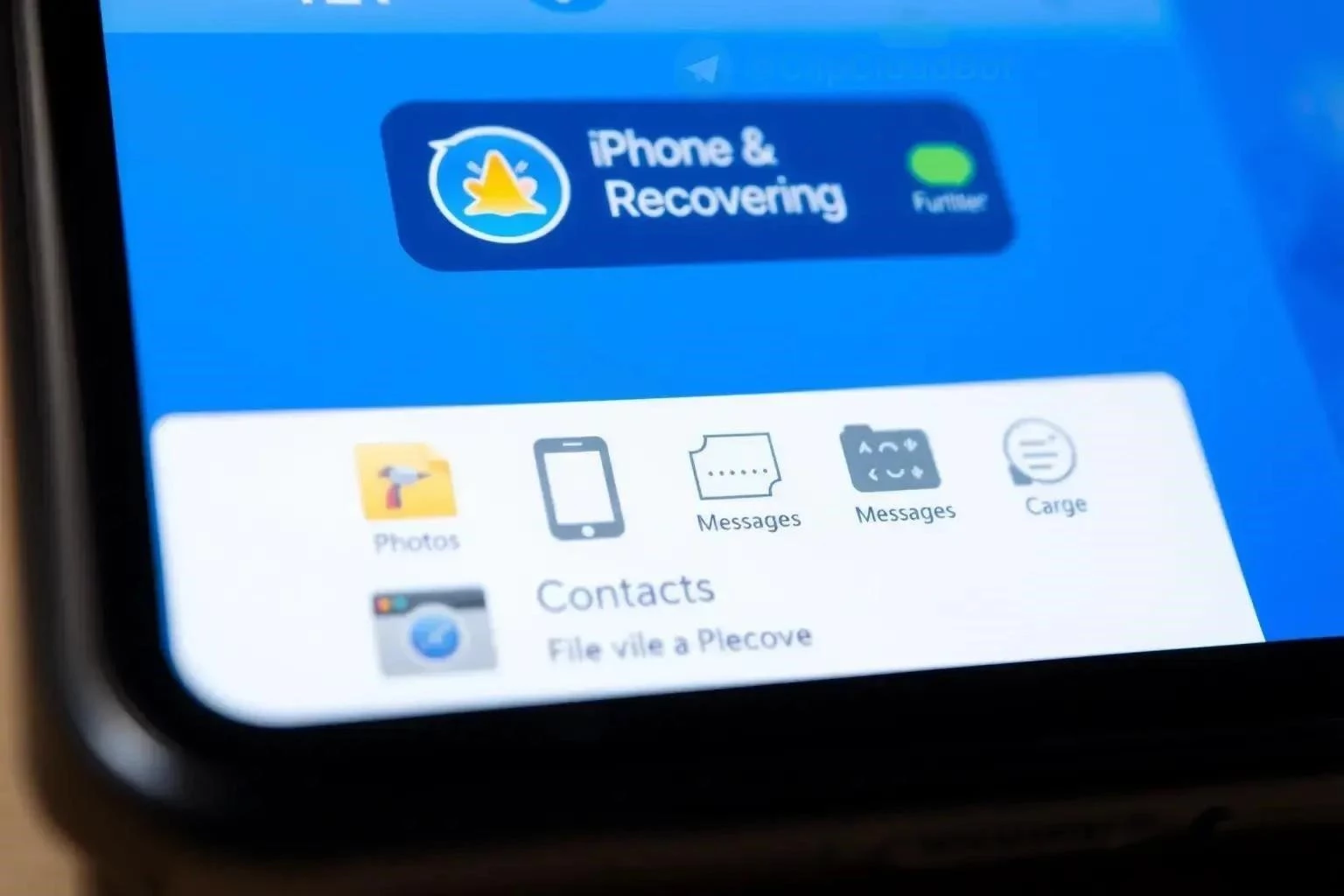Losing precious data from your iPhone can be a distressing experience․ Whether it’s cherished photos, important contacts, or crucial documents, the thought of losing it all can be overwhelming․ Fortunately, even without a recent backup, there are expert methods available to recover lost or deleted data from your Apple iPhone․ This article explores how professionals can retrieve your valuable information, offering hope and practical solutions when you think all is lost․ We’ll delve into the techniques and tools used, providing insights into the process of iPhone data recovery without relying on backups․
Understanding iPhone Data Loss Scenarios and Recovery Possibilities
Data loss on an iPhone can occur due to various reasons, including accidental deletion, software updates gone wrong, physical damage, or even a forgotten passcode․ While having a backup is always recommended, it’s not always the case․ The good news is that even without a backup, data recovery is often possible․ Specialized software and techniques can scan the iPhone’s internal storage to locate and retrieve deleted files․
Common Causes of iPhone Data Loss
- Accidental deletion of photos, videos, or contacts․
- Failed iOS updates or jailbreaking attempts․
- Physical damage to the iPhone (water damage, screen damage)․
- Forgotten passcode leading to data wipe․
- Malware or virus infections (though rare on iOS)․
Expert Techniques for iPhone Data Recovery Without Backup
Data recovery experts employ sophisticated techniques to retrieve lost data from iPhones without backups․ These methods often involve analyzing the device’s file system and searching for remnants of deleted files․ The success of data recovery depends on several factors, including the amount of time that has passed since the data was lost and the extent to which the device has been used since then․
Advanced Data Recovery Methods
- Forensic Data Recovery: Using specialized hardware and software to directly access and analyze the iPhone’s memory chips․
- File System Analysis: Examining the iPhone’s file system to identify and reconstruct deleted files․
- Data Carving: Searching for specific file signatures within the iPhone’s storage to recover fragmented data․
Factoid: The Importance of Acting Quickly
Choosing the Right Data Recovery Expert for Your iPhone
Selecting a reputable and experienced data recovery expert is crucial for maximizing your chances of success․ Look for professionals with specialized knowledge of iOS devices and a proven track record of successful iPhone data recovery․ Check reviews and testimonials to ensure they have a good reputation and offer reliable services․
Key Considerations When Choosing a Data Recovery Service
- Experience with iOS devices: Ensure the service specializes in iPhone data recovery․
- Data privacy and security: Verify that the service has strict data protection policies․
- Success rate and testimonials: Check reviews and testimonials to assess their track record․
- Cost and turnaround time: Get a clear understanding of the costs involved and the estimated recovery time․
Factoid: Data Overwriting and Recovery Success
Fact: When data is deleted from an iPhone, it’s not immediately erased․ Instead, the space it occupied is marked as available for new data․ The longer you use your iPhone after data loss, the higher the risk of overwriting the deleted data, making recovery more difficult or impossible․
Preventing Future iPhone Data Loss
While data recovery is possible, prevention is always the best approach․ Regularly backing up your iPhone to iCloud or a computer is the most effective way to protect your data․ Consider enabling automatic backups to ensure your data is always up-to-date․
Tips for Preventing Data Loss
- Enable iCloud Backup and ensure it’s running regularly․
- Periodically back up your iPhone to a computer using iTunes or Finder․
- Be cautious when installing new apps or software updates․
- Avoid jailbreaking your iPhone, as it can increase the risk of data loss․
FAQ: iPhone Data Recovery Without Backup
Q: Is it really possible to recover data from an iPhone without a backup?
A: Yes, it is often possible, especially if you act quickly and seek professional help․ Data recovery experts can use specialized techniques to retrieve deleted files from the iPhone’s internal storage․
Q: How much does iPhone data recovery cost?
A: The cost of data recovery can vary depending on the complexity of the case and the service provider․ It’s best to get a quote from a reputable data recovery expert․
Q: How long does iPhone data recovery take?
A: The recovery time can vary depending on the extent of the data loss and the techniques used․ Some cases may be resolved within a few hours, while others may take several days․
Q: Is my data safe during the recovery process?
A: Reputable data recovery services have strict data protection policies to ensure the privacy and security of your data․
Q: What should I do immediately after realizing I’ve lost data on my iPhone?
A: Stop using your iPhone immediately to prevent overwriting the deleted data․ Contact a data recovery expert as soon as possible․
The Ethical Considerations of iPhone Data Recovery
While data recovery can be a lifesaver, it’s crucial to consider the ethical implications․ Ensure that you have the legal right to recover the data on the iPhone․ Recovering data from a device that doesn’t belong to you or without the owner’s consent is illegal and unethical․ Always prioritize respecting privacy and adhering to legal boundaries․
Navigating the Legal Landscape of Data Recovery
- Ownership Verification: Always confirm ownership of the device before initiating data recovery․
- Consent is Key: Obtain explicit consent from the owner if you are recovering data on their behalf․
- Data Privacy Laws: Be aware of data privacy laws in your region and ensure compliance․
DIY iPhone Data Recovery: Proceed with Caution
While numerous software programs claim to offer DIY iPhone data recovery, proceed with extreme caution․ Many of these programs are ineffective, and some may even damage your device or compromise your data security․ If you’re not technically proficient, it’s generally best to leave data recovery to the professionals․
Risks of DIY Data Recovery
- Data Overwriting: Incorrectly using recovery software can overwrite deleted data, making professional recovery impossible․
- Malware Infections: Some DIY recovery software may contain malware or viruses․
- Device Damage: Improper use of recovery tools can potentially damage your iPhone’s hardware or software․
Factoid: The Myth of Permanent Deletion
Beyond Data Recovery: Secure Data Wiping for iPhone Disposal
When disposing of an old iPhone, it’s essential to securely wipe all data to prevent unauthorized access․ Simply deleting files or performing a factory reset may not be sufficient․ Use specialized data wiping software or techniques to ensure that your personal information is permanently erased․
Secure Data Wiping Methods
- Data Wiping Software: Use reputable data wiping software that overwrites the entire storage medium multiple times․
- Encryption: Enable encryption on your iPhone before wiping the data․
- Physical Destruction: For highly sensitive data, consider physically destroying the storage medium․
Factoid: The Importance of Encryption
Fact: Encryption scrambles your data, making it unreadable to anyone without the correct decryption key․ Enabling encryption on your iPhone adds an extra layer of security and protects your data in case of loss or theft․
Future-Proofing Your Data: Proactive Data Management
The best way to avoid the stress and expense of data recovery is to implement proactive data management practices․ Regularly back up your iPhone, organize your files, and be mindful of your online security․ Taking these steps can significantly reduce your risk of data loss and protect your valuable information․
Proactive Data Management Strategies
- Regular Backups: Schedule automatic backups to iCloud or a computer․
- File Organization: Organize your files into folders and use descriptive filenames․
- Strong Passwords: Use strong, unique passwords for your Apple ID and other online accounts․
- Two-Factor Authentication: Enable two-factor authentication for added security․
- Software Updates: Keep your iPhone’s operating system and apps up-to-date․
Final Thoughts: Data Recovery as a Last Resort
While iPhone data recovery without backup is possible, it should be considered a last resort․ The success of data recovery is never guaranteed, and the process can be time-consuming and expensive․ By implementing proactive data management practices and regularly backing up your iPhone, you can significantly reduce your risk of data loss and protect your valuable information․ Remember, prevention is always better than cure․
Staying Informed: The Evolving Landscape of Data Recovery Technology
The field of data recovery is constantly evolving, with new techniques and technologies emerging regularly․ Stay informed about the latest advancements in data recovery to better understand your options and make informed decisions․ Follow reputable tech blogs, industry publications, and data recovery experts on social media to stay up-to-date․
Emerging Trends in Data Recovery
- AI-Powered Data Recovery: Artificial intelligence is being used to analyze damaged storage media and identify recoverable data more efficiently․
- Cloud-Based Data Recovery: Some data recovery services are now offering cloud-based solutions, allowing you to recover data remotely․
- Advanced Forensic Techniques: Data recovery experts are employing advanced forensic techniques to recover data from severely damaged devices․
Understanding Data Loss Scenarios: Prevention is Key
Knowing the common causes of data loss can help you take preventative measures․ Data loss can occur due to a variety of factors, including accidental deletion, hardware failure, software corruption, malware infections, and physical damage․ By understanding these risks, you can implement strategies to mitigate them․
- Accidental Deletion: Be careful when deleting files, photos, and messages․
- Hardware Failure: Protect your iPhone from physical damage and extreme temperatures․
- Software Corruption: Keep your iPhone’s operating system and apps up-to-date․
- Malware Infections: Avoid downloading apps from untrusted sources and use a reputable antivirus app․
- Water Damage: Keep your iPhone away from water and other liquids․
Factoid: The Role of Solid-State Drives (SSDs) in Data Recovery
The Importance of Professional Data Recovery Services
While DIY data recovery tools may seem tempting, they often lack the sophistication and expertise required for successful recovery․ Professional data recovery services have specialized equipment, trained technicians, and years of experience in handling complex data loss scenarios․ They can significantly increase your chances of recovering your valuable data․
Benefits of Using Professional Data Recovery Services
- Expertise and Experience: Professionals have the knowledge and skills to handle a wide range of data loss situations․
- Specialized Equipment: They use advanced tools and equipment to recover data from damaged devices․
- Cleanroom Environment: Some data recovery services have cleanroom environments to prevent further damage to sensitive storage media․
- Data Security: Reputable services have strict data protection policies to ensure the privacy and security of your data․
Factoid: Data Recovery and the “Trim” Command
Fact: The “Trim” command, used in SSDs, optimizes performance by proactively erasing unused data blocks․ While beneficial for performance, it can make data recovery more difficult because the data is physically erased sooner than on traditional HDDs․
Beyond the iPhone: Data Recovery for Other Apple Devices
The principles of data recovery apply not only to iPhones but also to other Apple devices, such as iPads, MacBooks, and iMacs․ If you experience data loss on any of these devices, the same recommendations apply: stop using the device immediately and seek professional help․
Data Recovery for Other Apple Devices
- iPads: Data recovery from iPads is similar to iPhones, with the same considerations for backups and professional assistance․
- MacBooks and iMacs: Data recovery from Mac computers can be more complex due to the larger storage capacities and operating system․
- Apple Watch: While less common, data loss can also occur on Apple Watches․ Contact a data recovery expert for assistance․
Final Reminder: Prioritize Data Backups for Peace of Mind
The most important takeaway is the critical need for regular and reliable data backups․ Whether you choose iCloud, iTunes, or a third-party backup solution, make sure your data is backed up regularly․ This will provide you with peace of mind knowing that your valuable information is protected in case of data loss․ Don’t wait until it’s too late ⏤ start backing up your iPhone today!

